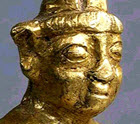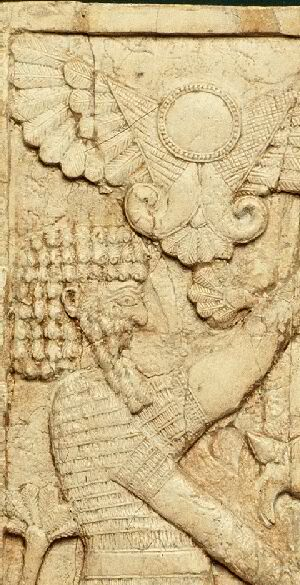Bearded Man Holding Tendrils

Stone Relief of a
Bearded Man Holding Tendrils
MET
Excerpt
Panel with bearded male holding tendrils, 8th century
B.C.; Neo-Assyrian period; Syrian style
Excavated at Fort Shalmaneser, Nimrud (ancient Kalhu), Mesopotamia
Ivory; H. 10.5 in. (26.7 cm)
Rogers Fund, 1961 (59.107.6)
Description
"In contrast to the grand, stylized reliefs that flanked the walls of the palace of Ashurnasirpal II at Nimrud are the delicate ornamental ivories that once adorned royal furniture. Ivory, prized throughout the ancient world, was used extensively at the time of the Assyrian Empire (ca. 883�612 B.C.). The material was valued by craftsmen because it could be carved in such detail. Although modern tastes appreciate the beauty of an ivory surface, these carvings were often covered with gold foil. Many of the ivories found at Nimrud were brought as booty or tribute from the vassal states to the west of Assyria, where elephants were native and ivory carving was a long-established craft. Others were undoubtedly carved in Assyria by craftsmen brought as captives to the capital cities. Contemporary inscriptions record that Ashurnasirpal took "couches of ivory overlaid with gold" from a city on the western Tigris and received tribute of "elephant tusks and ivory thrones overlaid with gold and silver." Thousands of ivory fragments were discovered by the British in their excavations of the ruins of Nimrud. Stripped of their gold covering by invading armies, the ivories themselves were discarded as being of little worth.
Syrian-style ivories have been found in
Syria�particularly at the site of Arslan Tash�as well as in the Assyrian
palaces of northern Mesopotamia. Works in this style include both flat
panels used for furniture decoration and such three-dimensional objects
as circular boxes and small figures. Syrian-style ivory carving is
distinguished by the stocky proportions of the figures, oval faces with
small mouths and large eyes, plants with a long wavy stem, and a winged
sun disc with pendant volute curls. Unlike the symmetrical compositions
of Phoenician ivories, Syrian examples often depict a single figure in
profile that completely fills the surface of the plaque. Nude female
figures wearing elaborately curled tresses and diadems, sculpted in the
round either singly or in groups, are a particularly striking theme.
Syrian-style ivories were made primarily during the ninth and eighth
centuries B.C.
This ivory carving would have been one of a group of similar panels used
in the back of a chair. It depicts a bearded man, perhaps a warrior,
holding the stem of a lotus plant. Above him, a winged disc provides
protection" -
MET
"In the year that Tartan came unto Ashdod, (when Sargon the king of Assyria sent him,) and fought against Ashdod, and took it;" - Isaiah 20:1
Copyright � 2001 The Metropolitan Museum of Art - MET
Return to Bible History Online
Read The Bible
- 1599 Geneva Bible (GNV)
- 21st Century King James Version (KJ21)
- American Standard Version (ASV)
- Amplified Bible (AMP)
- Amplified Bible, Classic Edition (AMPC)
- Authorized (King James) Version (AKJV)
- BRG Bible (BRG)
- Christian Standard Bible (CSB)
- Common English Bible (CEB)
- Complete Jewish Bible (CJB)
- Contemporary English Version (CEV)
- Darby Translation (DARBY)
- Disciples’ Literal New Testament (DLNT)
- Douay-Rheims 1899 American Edition (DRA)
- Easy-to-Read Version (ERV)
- English Standard Version (ESV)
- English Standard Version Anglicised (ESVUK)
- Evangelical Heritage Version (EHV)
- Expanded Bible (EXB)
- GOD’S WORD Translation (GW)
- Good News Translation (GNT)
- Holman Christian Standard Bible (HCSB)
- International Children’s Bible (ICB)
- International Standard Version (ISV)
- J.B. Phillips New Testament (PHILLIPS)
- Jubilee Bible 2000 (JUB)
- King James Version (KJV)
- Lexham English Bible (LEB)
- Living Bible (TLB)
- Modern English Version (MEV)
- Mounce Reverse Interlinear New Testament (MOUNCE)
- Names of God Bible (NOG)
- New American Bible (Revised Edition) (NABRE)
- New American Standard Bible (NASB)
- New American Standard Bible 1995 (NASB1995)
- New Catholic Bible (NCB)
- New Century Version (NCV)
- New English Translation (NET)
- New International Reader's Version (NIRV)
- New International Version - UK (NIVUK)
- New International Version (NIV)
- New King James Version (NKJV)
- New Life Version (NLV)
- New Living Translation (NLT)
- New Matthew Bible (NMB)
- New Revised Standard Version (NRSV)
- New Revised Standard Version Catholic Edition (NRSVCE)
- New Revised Standard Version, Anglicised (NRSVA)
- New Revised Standard Version, Anglicised Catholic Edition (NRSVACE)
- New Testament for Everyone (NTE)
- Orthodox Jewish Bible (OJB)
- Revised Geneva Translation (RGT)
- Revised Standard Version (RSV)
- Revised Standard Version Catholic Edition (RSVCE)
- The Message (MSG)
- The Voice (VOICE)
- Tree of Life Version (TLV)
- World English Bible (WEB)
- Worldwide English (New Testament) (WE)
- Wycliffe Bible (WYC)
- Young's Literal Translation (YLT)
Table of Contents

Ancient Near East Art
- Female Worshipper- Uruk
- Funerary Head of an Elamite
- Stele of Mesha, King of Moab
- Sarcophagus of Eshmunazor II, king of Sidon
- Stele Showing the Storm-God Baal
- Fertility Goddess - Ugarit
- Oskoron I - Byblos
- The Spinner Relief
- The Archers of Darius
- Bull Capital From Darius I Palace
- Sargon II and a High Official
- Tablet of Sargon's 8th Campaign
- Winged Assyrian Bulls
- Law-Codex of Hammurabi
- Hero Choking a Small Lion
- Kudurru of Melishihu
- Hittite God - Gold Figurine
- Seated Statue of Gudea, prince of Lagash
- Foundation Nail Of Ur Ba'u
- Cylinder-Seal Of Sharkalisharri
- Victory Stele of Naram-Sin
- Urnanshe (King of Lagash) Relief
- Ebih-II, the Superintendent of Mari
- Tablet Of Pre-Cuneiform Script
- King and Eunuch Attendant Relief
- Human-Headed Winged Bull
- Bearded Man Holding Tendrils
- Nubian With Animals and Skins
- Head of a Roaring Lion
- Cylinder Seal With Impression
- Orthostat Relief - Hunting Scene
- Sphinx Plaques
- Throne With Bull Deity
Ancient Egypt
- Model of a Riverboat
- Ritual Figure of the 12th Dynasty
- Stela of Mentuwoser
- Coffin of Khnum-nakht
- Sphinx of Senwosret III
- Face of Senwosret III
- Pectoral with the Name of Senwosret II
- Cat
- Statuette of a Hippopotamus
- Seated Statue of Hatshepsut
- Ostracon of Senenmut
- Chair of Renyseneb
- Heart Scarab of Hatnofer
- Kneeling Statue of Tuthmosis III
- Arm Panel from a Ceremonial Chair
- Sphinx of Amenhotep III
Mediterranean
Main Menu
- Ancient Assyrian Social Structure
- Ancient Babylonia
- Ancient Canaan During the Time of Joshua
- Ancient History Timeline
- Ancient Oil Lamps
- Antonia Fortress
- Archaeology of Ancient Assyria
- Assyria and Bible Prophecy
- Augustus Caesar
- Background Bible Study
- Bible
- Biblical Geography
- Fallen Empires - Archaeological Discoveries and the Bible
- First Century Jerusalem
- Glossary of Latin Words
- Herod Agrippa I
- Herod Antipas
- Herod the Great
- Herod's Temple
- High Priest's in New Testament Times
- Jewish Literature in New Testament Times
- Library collection
- Map of David's Kingdom
- Map of the Divided Kingdom - Israel and Judah
- Map of the Ministry of Jesus
- Matthew Henry Bible Commentary
- Messianic Prophecy
- Nero Caesar Emperor
- Online Bible Maps
- Paul's First Missionary Journey
- Paul's Second Missionary Journey
- Paul's Third Missionary Journey
- Pontius Pilate
- Questions About the Ancient World
- Tabernacle of Ancient Israel
- Tax Collectors in New Testament Times
- The Babylonian Captivity
- The Black Obelisk of Shalmaneser
- The Books of the New Testament
- The Court of the Gentiles
- The Court of the Women in the Temple
- The Destruction of Israel
- The Fall of Judah with Map
- The History Of Rome
- The Incredible Bible
- The Jewish Calendar in Ancient Hebrew History
- The Life of Jesus in Chronological Order
- The Life of Jesus in Harmony
- The Names of God
- The New Testament
- The Old Testament
- The Passion of the Christ
- The Pharisees
- The Sacred Year of Israel in New Testament Times
- The Samaritans
- The Scribes
Ancient Questions
- Why Do the Huldah Gates Appear Different in Ancient Replicas and Modern Photos?
- What Is the Origin of the Japanese and Chinese Peoples? A Biblical Perspective
- How did the ancient Greeks and Romans practice medicine and treat illnesses?
- What were the major contributions of ancient Babylon to mathematics and astronomy?
- How did the ancient Persians create and administer their vast empire?
- What were the cultural and artistic achievements of ancient India, particularly during the Gupta Empire?
- How did ancient civilizations like the Incas and Aztecs build their remarkable cities and structures?
- What were the major trade routes and trading practices of the ancient world?
- What was the role of slavery in ancient societies like Rome and Greece?
- How did the ancient Mayans develop their sophisticated calendar system?
Bible Study Questions
- Why Do Christians Celebrate Christmas?
- How Many Chapters Are There in the Bible?
- The Five Key Visions in the New Testament
- The 400-Year Prophecy: Unpacking Genesis 15 and the Journey of a People
- The Authorized (King James) Version (AKJV): Historical Significance, Translation Methodology, and Lasting Impact
- Exploring the English Standard Version (ESV): Its Aspects, Comparisons, Impact on Biblical Studies, and Church Use
- A Detailed Historical Analysis of Language Updates in the KJ21: Comparison with Other Versions
- A Detailed Historical Analysis of the American Standard Version (ASV): Comparison to the King James Version, Influence on Later Translations, and Evaluation of Strengths and Weaknesses
- A Detailed Historical Analysis of Amplifications in the Amplified Bible (AMP) and Its Comparison to Other Bible Translations
- Detailed Historical Analysis of the Amplified Bible Classic Edition (AMPC): Examples of Amplifications and Comparative Analysis with Other Bible Translations
About
Welcome to Free Bible: Unearthing the Past, Illuminating the Present! Step into a world where ancient history and biblical narratives intertwine, inviting you to explore the rich tapestry of human civilization.
Discover the captivating stories of forgotten empires, delve into the customs and cultures of our ancestors, and witness the remarkable findings unearthed by dedicated archaeologists.
Immerse yourself in a treasure trove of knowledge, where the past comes alive and illuminates our understanding of the present.
Join us on this extraordinary journey through time, where curiosity is rewarded and ancient mysteries await your exploration.
Recent posts
-

How to Build a Modern Slot Machine Engine: Math Models and RTP Design
Introduction: The Heart of Modern Slots Slot machines have evolved tremendously since the first mechanical reels appeared in the 1890s. Digital techno... -

Why Discipleship Ministries Matter: How They Shape Churches and Communities
Discipleship ministries have traditionally played an important role in Christians' spiritual growth and the long-term viability of their churches. Chr... -

A Historical Journey of Health Insurance: From Ancient Mutual Aid to Modern Coverage
The modern form of health insurance, which is premium based, pooled risk financial coverage during illness is a relatively new development. But the th... -

Get a Crypto License in Poland - Secure, EU-Ready, and Backed by Prifinance Expertise
Expand your crypto business legally in the European Union with a crypto license in Poland under the MiCA framework. Poland has become one of the most ... -

Why Partnering with the Right Mobile App Development Company Can Make or Break Your Project
Why Partnering with the Right Mobile App Development Company Can Make or Break Your Project In today's hyperconnected world, your app is frequently yo...
